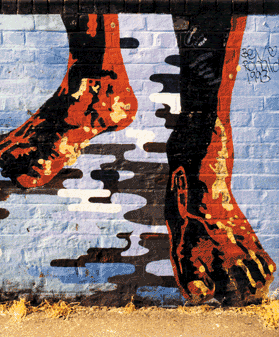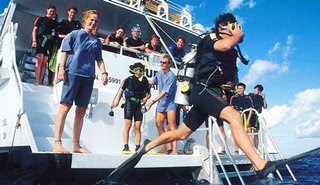 Just a couple of weeks before I entered Tibet, a group of four Americans and one Tibetan-American had hiked to the base of mount Everest and unfurled a simple homemade sign. They were each almost immediately arrested by the Chinese authorities, but not before one of them managed to transmit a live feed of a video recording of their activities. The five individuals were detained for several days and then permanently expelled from China. The Chinese Foreign Ministry said that they were arrested for "carrying out illegal activities aimed at splitting China," and that they had been expelled according to Chinese law. Shortly thereafter the Chinese announced a new policy of travel restrictions for foreigners in Tibet. To travel out of the capital city of Lhasa now required a costly "Alien Travel Permit" and the hiring of an official Chinese guide that would accompany foreign groups at all times. There were a lot of pissed of foreigners complaining about their spoiled travel plans when I arrived. I found the whole thing fascinating.
Just a couple of weeks before I entered Tibet, a group of four Americans and one Tibetan-American had hiked to the base of mount Everest and unfurled a simple homemade sign. They were each almost immediately arrested by the Chinese authorities, but not before one of them managed to transmit a live feed of a video recording of their activities. The five individuals were detained for several days and then permanently expelled from China. The Chinese Foreign Ministry said that they were arrested for "carrying out illegal activities aimed at splitting China," and that they had been expelled according to Chinese law. Shortly thereafter the Chinese announced a new policy of travel restrictions for foreigners in Tibet. To travel out of the capital city of Lhasa now required a costly "Alien Travel Permit" and the hiring of an official Chinese guide that would accompany foreign groups at all times. There were a lot of pissed of foreigners complaining about their spoiled travel plans when I arrived. I found the whole thing fascinating.How five people with a sign and a video camera were able to create such a disturbance and incite such a swift and drastic reaction from the Chinese Government is an indication of both the potential strength of this form of protest in the modern technical age, as well as the weakness of the moral ground of the Chinese position on Tibet. The sign read: "One World, One Dream, Free Tibet 2008," a strategic play on the slogan of the Beijing Olympic Games. Within hours of the incident, news of the protester's arrest was on the Internet along with a downloadable version of the footage through YouTube.
Timing was everything.
 Organizers of the Beijing 2008 Summer Olympics were just about to announce the much anticipated Olympic torch route. What they had planned was the most ambitious in Olympic history, including the longest torch relay ever — an 85,000-mile, 130-day route that would cross five continents. The highlight of this remarkable route would be when a team of Chinese, bearing the Olympic torch, scaled the 29,028 feet to the top of Mount Everest.
Organizers of the Beijing 2008 Summer Olympics were just about to announce the much anticipated Olympic torch route. What they had planned was the most ambitious in Olympic history, including the longest torch relay ever — an 85,000-mile, 130-day route that would cross five continents. The highlight of this remarkable route would be when a team of Chinese, bearing the Olympic torch, scaled the 29,028 feet to the top of Mount Everest.At the time of the protest a Chinese team was already at Everest Base Camp looking into the practical aspects of bringing a lit torch to the top of the highest mountain in the world, as well as the logistics of broadcasting their progress to the world live. There have been some unconventional methods used in the past to transport the Olympic torch - it has traveled by elephant in India; camel at the Pyramids in Egypt; and by tram in Rio de Janeiro. In the 2000 Olympics the Australians designed a torch that could stay ignited under water as it was brought down to the Great Barrier Reef by scuba divers. The carrying of the torch has become an integral part of the Olympic tradition and perhaps the most widely viewed event of the Olympic ceremonies. The torch that the Chinese intend to bring to Everest will be outfitted with a special oxygen tank to keep it burning in the thin air and an igniter to re-light the flame when gusting winds blow it out. It will also be the first ever live-broadcast of an attempted summit of Everest. One thing is for sure - the whole world will be watching. So, the implications of the actions of the small band of protesters was not lost on the Chinese Government - if they are not careful, rather than seeing the glory of China on their carefully choreographed day, the world might instead be watching segments that highlight China's highly controversial occupation of Tibet.

Tibet isn't the only controversial stop on the torch's path either. China is also using the torch's route to make political statements about the status of Taiwan. Beijing considers Taiwan a renegade state and has claimed sovereignty over the self-ruled democratic island since the losing nationalists fled there at the end of the Chinese Civil War in 1949. China has repeatedly threatened to bring the island back into the fold, by force if necessary. When discussing the Olympic torch route, the executive vice president of the Beijing Olympic organising committee, has repeatedly referred to Taipei (Taiwan's capital) as an "overseas Chinese city". Then it came out that the Taiwan leg of the Olympic torch relay has been designated a part of the "domestic route," thereby creating the misimpression that Taiwan is a region under China's control. Officials in Taiwan are furious.
But maybe some good can come from this in the end.

The very first Olympic Games were held in 776 B.C. at the sanctuary of Zeus in Olympia, Greece. From its start the Olympics marked the beginning of a period of peace for the often warring Greeks. At the start of the Games, torch bearers would be sent out to travel throughout Greece, declaring a "sacred truce" to all wars between rival city-states. The truce would remain in place for the duration of the games, so that spectators could safely travel to the Olympics.
Perhaps the progress of the torch through the controversial regions of China's politics during this period of intense international attention will force issues to the surface that have until now had very little opportunity for public discussion within China. One can only hope.


 Late one night in an Internet cafe in Shanghai, as people were clearing out and only the owner and a couple of kids playing video games were left, I decided to give Chinese censorship a test. I took a look over my shoulder, typed in "Tiananmen square 1989", and clicked search. No Red Guard soldiers stormed the building, but the results were telling. Many of the sites that came up were of general tourist information, inviting me to visit the Great Hall of the People, the Monument to the People's Heroes, and Mao Zedong Memorial Hall. No mention of any protesters being mowed down by the Chinese military yet. A few sites with informative soundings titles did appear, but when I clicked on these, a window opened up telling me that the sites were unavailable. When I did a google search for images using "Tiananmen square 1989", I got nothing. Not one image!
Late one night in an Internet cafe in Shanghai, as people were clearing out and only the owner and a couple of kids playing video games were left, I decided to give Chinese censorship a test. I took a look over my shoulder, typed in "Tiananmen square 1989", and clicked search. No Red Guard soldiers stormed the building, but the results were telling. Many of the sites that came up were of general tourist information, inviting me to visit the Great Hall of the People, the Monument to the People's Heroes, and Mao Zedong Memorial Hall. No mention of any protesters being mowed down by the Chinese military yet. A few sites with informative soundings titles did appear, but when I clicked on these, a window opened up telling me that the sites were unavailable. When I did a google search for images using "Tiananmen square 1989", I got nothing. Not one image!



















 I remember the excitement of my first dive, when I turned upside-down and saw the light refracting on the surface. I watched as my bubbles floated up towards the light and I realized for the first time that I didn't have to make a dash up there for air. Just the feeling of weightlessness, being able to hover suspended in space, rising and falling slightly with each breath - it is one of those truly amazing experiences. Then of course there is the underwater world to explore.
I remember the excitement of my first dive, when I turned upside-down and saw the light refracting on the surface. I watched as my bubbles floated up towards the light and I realized for the first time that I didn't have to make a dash up there for air. Just the feeling of weightlessness, being able to hover suspended in space, rising and falling slightly with each breath - it is one of those truly amazing experiences. Then of course there is the underwater world to explore.






















